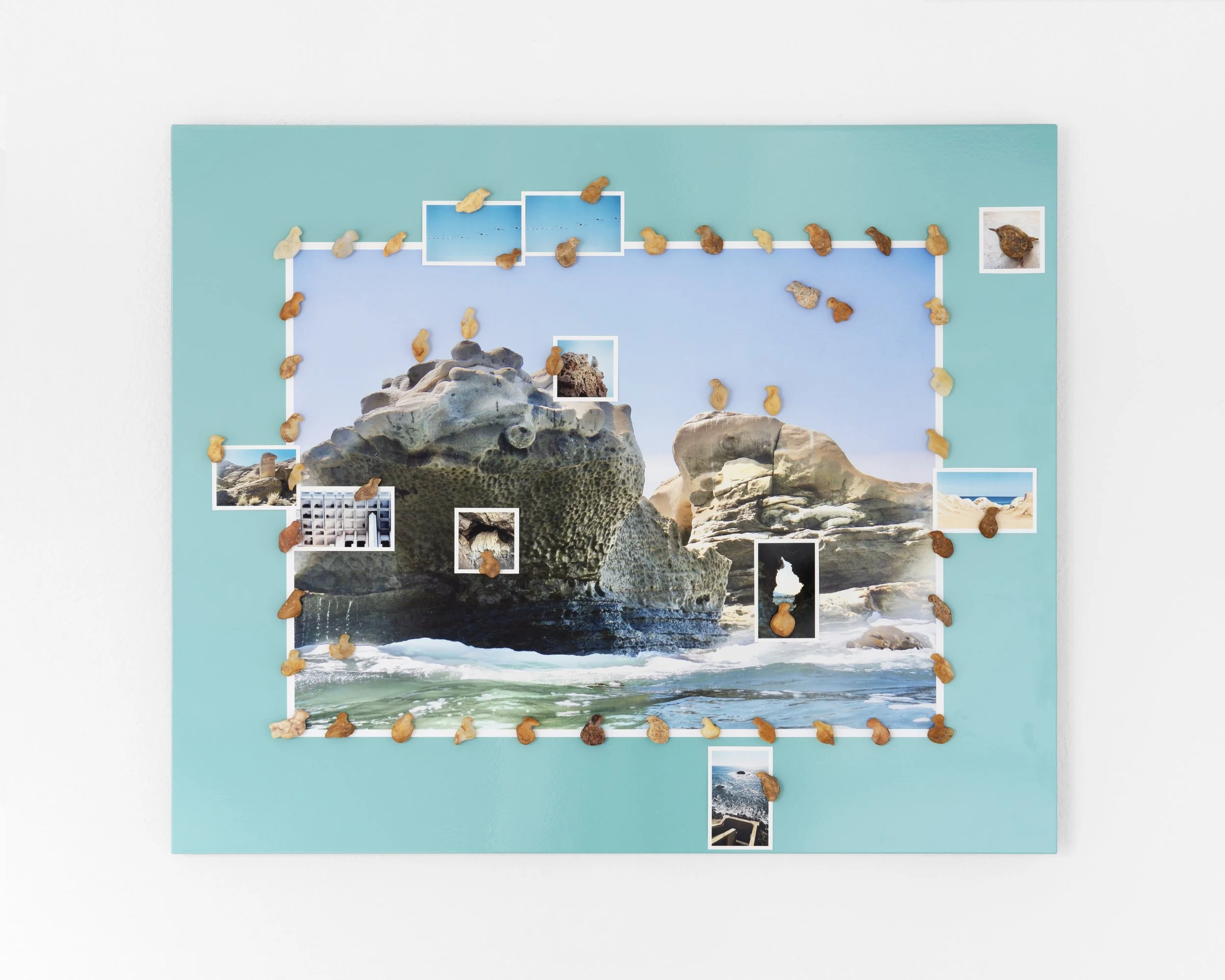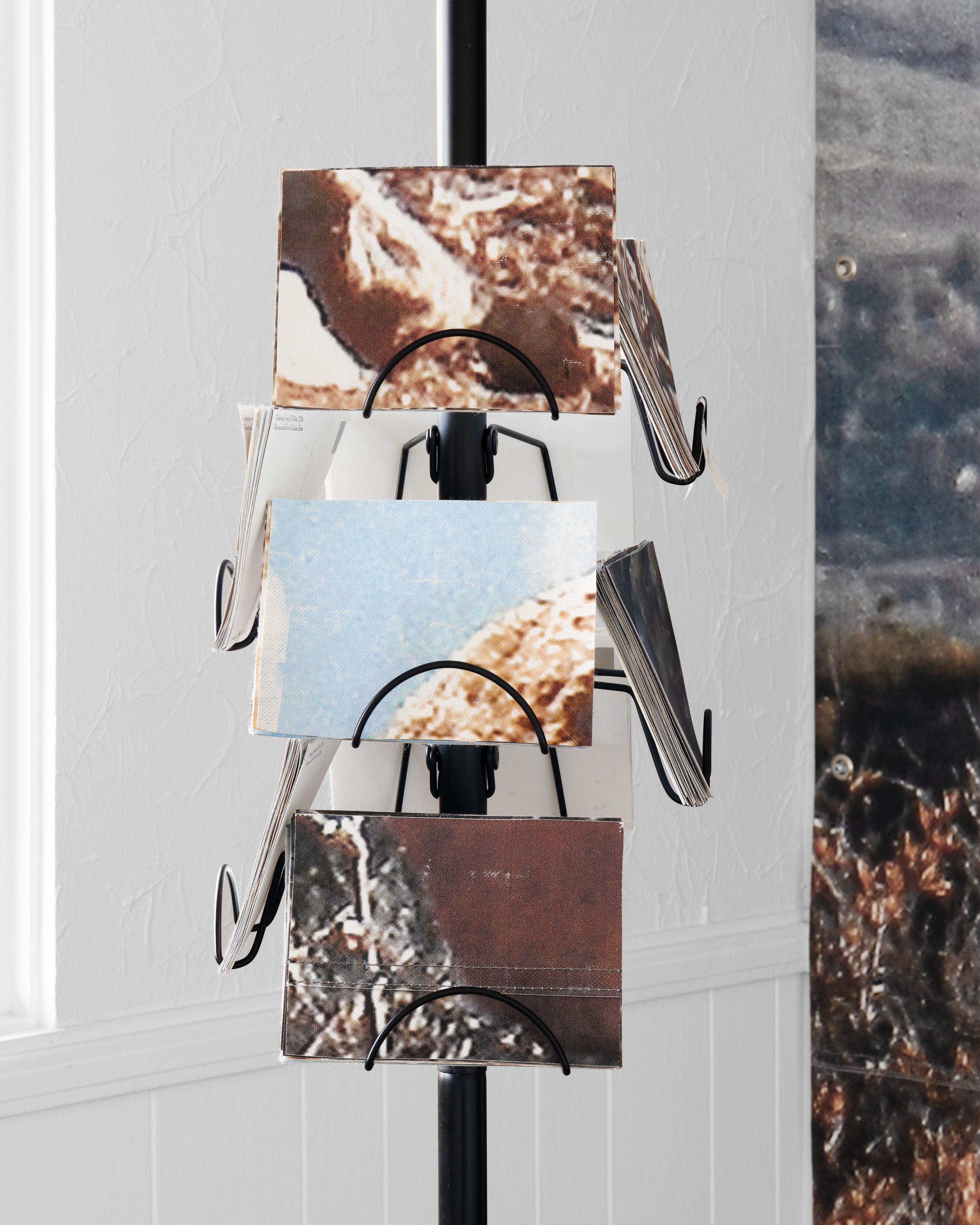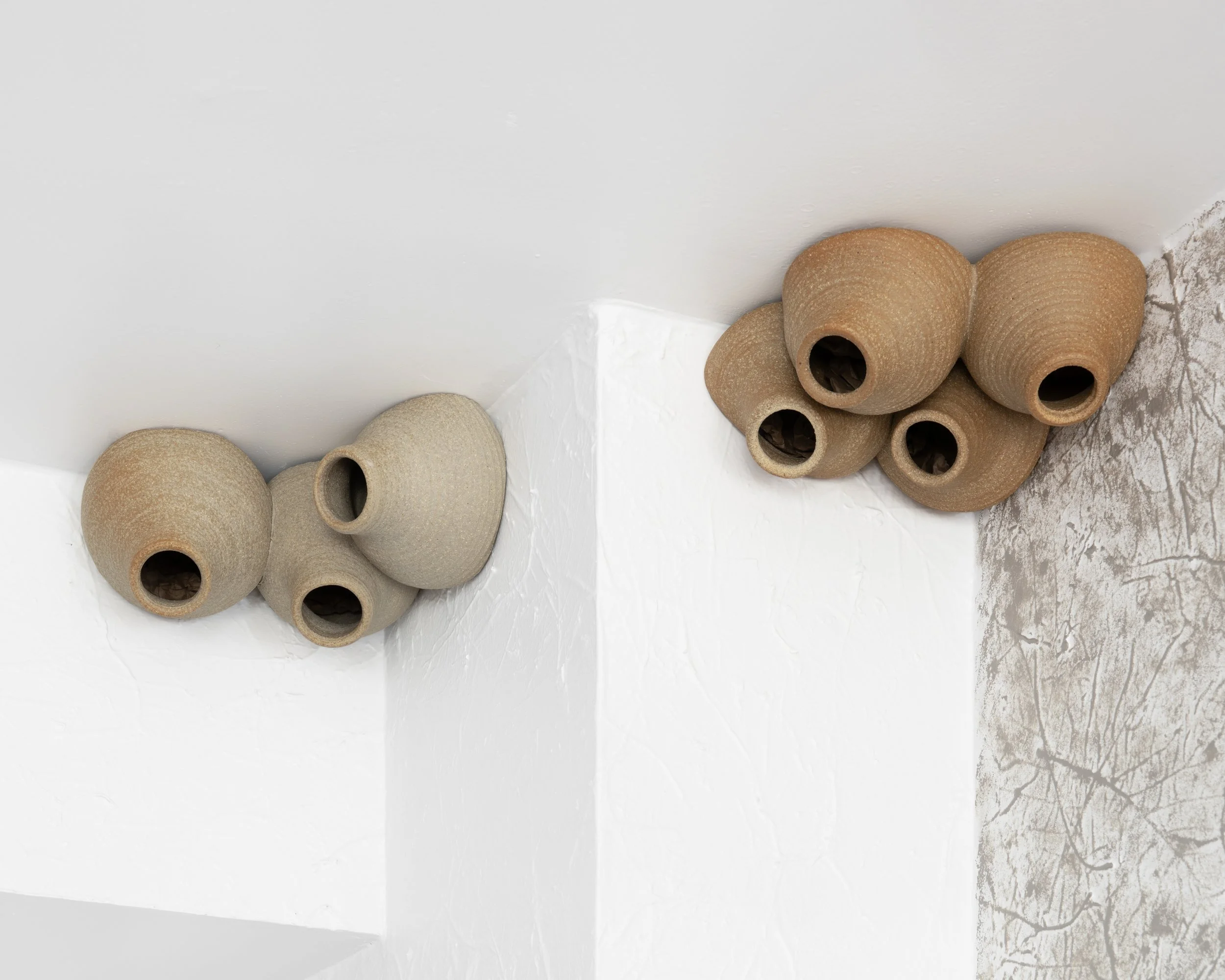O Petravia
Roman de Salvo
Curated by Lizzie Zelter
September 15 - October 19, 2024
Roman de Salvo Eye Contact, 2024 Four inkjet prints on Epson Exhibition Fiber mounted on gessoed hardboard 6 ½ x 8 ½ in. each
Roman de Salvo Keystone, 2024 Vinyl salvaged from McCairn, grommets, Dye Sublimation print on Kodak Ribbon paper, carved and tumbled beach pebbles, rare earth magnet 8 ½ x 11 ¾ ft.
Roman de Salvo Magnetic Seafoam Birdstone Colony, 2024 Inkjet print on Epson Exhibition Fiber, powder coated steel, carved and tumbled beach pebbles, rare earth magnets 24 x 29 in.
Roman de Salvo Corner Colony Sixplex, 2024 Stoneware 8 x 11 ¼ x 12 ½ in.
Roman de Salvo and Lizzie Zelter Greetings from McCairn, 2024 Letterpress prints on vinyl salvaged from McCairn, adapted pole lamp mast, steel, hardware 8 ½ x 1 x 1 ft.
Roman de Salvo Waving, 2024 Six inkjet prints on Epson Exhibition Fiber mounted on gessoed hardboard 6 ½ x 8 ½ in. each
Roman de Salvo Hello, Hollow, 2024 Inkjet print on Epson Exhibition Fiber, laminated hardboard, gesso, shellac 22 x 32 ¼ x 2 ¼ in.
Installation view
Two Rooms is proud to present O Petravia, a solo exhibition of Roman de Salvo (b. 1965, San Francisco, CA), a sculptor and public artist who infuses everyday materials, imagery, and language with a unique sense of humor and poetic intrigue. His work often involves energetic phenomena, such as wind, water, fire, and electricity, as well as elements of surprise, audience participation, and problem solving. The eleven pieces in O Petravia reveal de Salvo’s penchant for noticing traces and honoring what he calls “landscape keepsakes,” tactile souvenirs.
This exhibition came from the fortuitous location of de Salvo’s mural for Murals of La Jolla, McCairn, visible from Two Rooms. To make McCairn, de Salvo hiked McGinty Mountain, constructed the letter “M” out of three cairns connected by two keystones, and photographed it. Reminiscent of the McDonald’s golden arches, the mural operated as a drive-by billboard. After McCairn was taken down, extending the lifespan of the 18 by 25-foot vinyl became the basis for this show.
For O Petravia, De Salvo cut and bound the vinyl to form a new work, Keystone. One can simultaneously see the revived segment along with the empty billboard. As an indoor wall piece, Keystone collapses the visual distance of the billboard and allows viewers to experience the crinkled, pixelated image from inches away. De Salvo often incorporates the contextual architecture into his work, heightening or transforming its meaning. Here, the right arch is positioned as though it were propping up the ceiling.
A second iteration of recycling McCairn occurred through a collaboration between de Salvo and Lizzie Zelter. To contrast the large, stationary, and public experience of the billboard, the two made a series of postcards: small, mobile objects intended for private exchange. Greetings from McCairn objectifies an image, recalling a National Park gift shop where a vast experience is condensed into a physical memento. However, the postcards also provide visitors with their own landscape keepsake, this time made of weathered vinyl.
De Salvo’s method in making McCairn, enacting a deed or stunt, documenting it, and turning it into a physical thing, became his guiding principle for O Petravia. He engaged the neighborhood’s namesake, an offshore sandstone formation known as Bird Rock. Intrigued by the rock’s cavernous center, de Salvo snorkeled out with a waterproof camera. The resulting pictures portray a shifting horizon line with blurred splash marks, revealing de Salvo’s amphibious point of view. Printed in the dimensions of tourist postcards, Waving and Eye Contact are installed as sequential groupings.
A photograph of Bird Rock sans birds became the backdrop for de Salvo’s Birdstones. Considering ways in which we preserve the life of images, he thought of refrigerator magnets. Thus came the artist’s smallest sculptures to date, beach pebbles carved and tumbled into abstract birds. Magnetic Seafoam Birdstone Colony is a scrapbook bulletin board where vignettes from near and far are placed on the central image. Brilliantly, Birdstones merge form and function by populating the empty rock with birds, while holding the images in place on the Seafoam steel substrate.
De Salvo’s Corner Colonies, ceramic sculptures of cliff swallow nest colonies, populate the upper corners of Two Rooms. This series, ranging from a duplex to a sixplex, harks back to de Salvo’s long-standing investigation of domestic settings and the wondrous innovations of construction. These sculptures, along with Hello, Hollow, a photograph of Bird Rocks’ mouth-like cave mounted in an arched hardboard frame, draw out the artist’s attention to natural forms and their reverberations in human-made spaces.
A billboard and postcards, birds waving and making eye contact, and construction strategies deployed in nests and rock formations: the works in this show are unified by de Salvo’s astute sensitivity to signals of communication and what it means to leave a trace. Altogether, these pieces tell a layered story of the artist’s adventures in an enchanting land of rocks and birds. O Petravia can be anywhere; it can take the form of an ode to the real neighborhood of Bird Rock or in the case of this show, as a survey of an imagined place through photography, sculpture, and installation.








